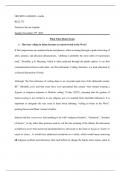Exam (elaborations)
Veiling_in_the_West_and_Biological_Essen
- Course
- Institution
Final Take Home Exam 1. Howhasveiling in Islam become so controversial in the West? If first impressions are unuttered looks and glances, often occurring through a quick observing of attire, posture, and physical demarcations, “clothing is probably the most silent of expressions used.” ...
[Show more]



